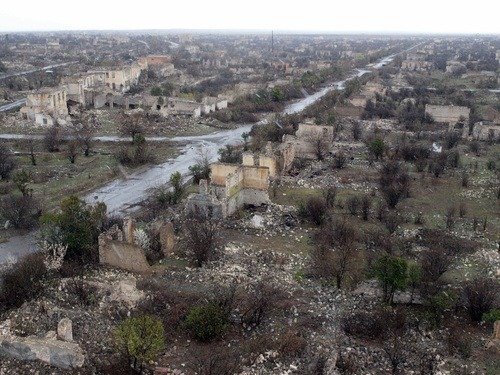
Feud of Tears
Ağdam, Azerbaijan
Journalist Paul Bradbury writes, “In this former town of 50,000 people we saw fifteen civilians (a mother and two sons were picking berries, which were growing wild in the main street; an elderly couple with their granddaughter were foraging for firewood; the others were collecting scrap metal) . . . On one broken gate I saw the number fifty. House number fifty, but which street? No other identification was evident. Even the roads had been dug up and all the pipes removed.” (Paul Bradbury, Total Croatia News.)
Located in Asia, Azerbaijan is the wealthiest of wealthy countries in the entire world, but situated in the southwest is the world’s largest dead city, Ağdam.
Crumbling edifices consumed by shifting sands and strangled by sylvan foliage are all that remains of this once culturally-rich city that had hardly seen a day of peace since founded in the 18th century.
Recently, the Nagorno-Karabakh War was an ethnic and territorial conflict that began in the late 1980s when the town was systematically blown apart in 1993. In 1994, while the rest of the world was celebrating the fall of the Soviet Union, thousands died in brutal ethnic battles across this region. Alastair Bonnet, a Professor of Social Geography at Newcastle University, writes in his book, Unruly Places, “War reports were being filed of the scalping, beheading, and mutilation of civilians, including children. Along with the dead, three million were displaced, among them all of those who once called Ağdam home.”
According to many writings, Ağdam was best known for its extravagant bazaars, wines, and burgundies which, of what remains, is still consumed by many former soviet states.
Hostility between Armenia and Azerbaijan has grown exponentially. Today, Ağdam is now diseased with political and ethnic conflicts in a superficial territorial war. Though a cease-fire has been declared, stubborn nationalists and separatists feeling dangerously overconfident and driven by racism, ego, and revenge have prolonged the torture, death and murder in vain.
Ağdam, a massive ghost town rich in culture, history and wealth brought to ruin, is still frequented by tourists, militia and adventurists, but fatal kidnappings, torture, and ethnic cleansing make this ghost town one of the deadliest places on Earth.
Thank you for taking the time to read my second article in my series, "Deadliest Places on Earth."
It's so tragic what happened to the city of Ağdam. Many great cities like Ağdam have been reduced to rubble in the name of war and hate, which begs to ask the question: do war and hate ever accomplish anything good?
I suppose to get a credible answer, we'd have those who once lived in this ghost town.
If you are interested in reading more articles like this one, please upvote this article and follow me so I know if you like them or not.
And if you'd like to own this article on Kindle, along with dozens more, definitely check out my book series, "Deadliest Places on Earth" which can be found on Amazon by clicking the link below.
Stay tuned, because tomorrow I'll be posting another "Deadliest Places" article, along with announcements of new projects in the works!
Congratulations @ransomelocke! You have completed the following achievement on the Steem blockchain and have been rewarded with new badge(s) :
You can view your badges on your Steem Board and compare to others on the Steem Ranking
If you no longer want to receive notifications, reply to this comment with the word
STOPVote for @Steemitboard as a witness to get one more award and increased upvotes!
Downvoting a post can decrease pending rewards and make it less visible. Common reasons:
Submit